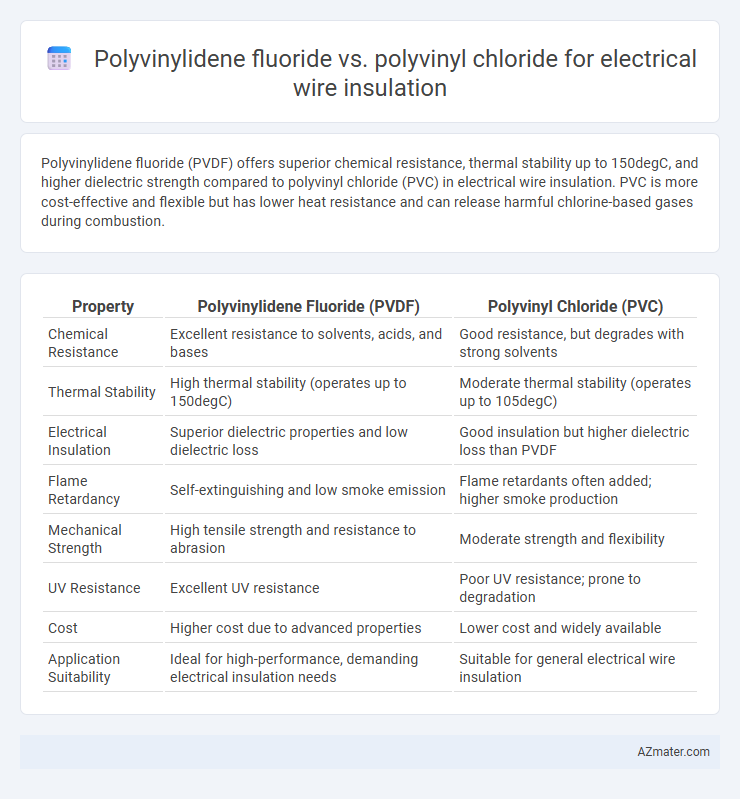Polyvinylidene fluoride (PVDF) offers superior chemical resistance, thermal stability up to 150degC, and higher dielectric strength compared to polyvinyl chloride (PVC) in electrical wire insulation. PVC is more cost-effective and flexible but has lower heat resistance and can release harmful chlorine-based gases during combustion.
Table of Comparison
| Property | Polyvinylidene Fluoride (PVDF) | Polyvinyl Chloride (PVC) |
|---|---|---|
| Chemical Resistance | Excellent resistance to solvents, acids, and bases | Good resistance, but degrades with strong solvents |
| Thermal Stability | High thermal stability (operates up to 150degC) | Moderate thermal stability (operates up to 105degC) |
| Electrical Insulation | Superior dielectric properties and low dielectric loss | Good insulation but higher dielectric loss than PVDF |
| Flame Retardancy | Self-extinguishing and low smoke emission | Flame retardants often added; higher smoke production |
| Mechanical Strength | High tensile strength and resistance to abrasion | Moderate strength and flexibility |
| UV Resistance | Excellent UV resistance | Poor UV resistance; prone to degradation |
| Cost | Higher cost due to advanced properties | Lower cost and widely available |
| Application Suitability | Ideal for high-performance, demanding electrical insulation needs | Suitable for general electrical wire insulation |
Introduction to Electrical Wire Insulation Materials
Polyvinylidene fluoride (PVDF) and polyvinyl chloride (PVC) are widely used materials for electrical wire insulation due to their distinct properties. PVDF offers superior chemical resistance, higher thermal stability up to 150degC, and excellent dielectric strength, making it ideal for high-performance and harsh environment applications. PVC is cost-effective, flexible, and provides good insulation up to 70degC, commonly used in residential and commercial wiring where moderate electrical and thermal demands prevail.
Overview of Polyvinylidene Fluoride (PVDF)
Polyvinylidene fluoride (PVDF) is a highly durable fluoropolymer used in electrical wire insulation due to its excellent chemical resistance, thermal stability, and mechanical strength. PVDF offers superior dielectric properties and UV resistance compared to polyvinyl chloride (PVC), making it ideal for harsh environmental conditions and high-performance applications. Its inherent flame retardancy and low smoke emission enhance safety standards in electrical wiring systems.
Overview of Polyvinyl Chloride (PVC)
Polyvinyl chloride (PVC) is a widely used thermoplastic polymer known for its excellent electrical insulation properties, chemical resistance, and durability in electrical wire insulation applications. Its high dielectric strength and flame retardancy make PVC a reliable choice for protecting electrical wires against moisture, abrasion, and electrical leakage. PVC's cost-effectiveness and ease of processing contribute to its extensive use in residential, commercial, and industrial wiring systems.
Electrical Properties: PVDF vs PVC
Polyvinylidene fluoride (PVDF) exhibits superior electrical properties compared to polyvinyl chloride (PVC), including a higher dielectric constant and excellent insulating capabilities, making it ideal for high-frequency and high-voltage wire insulation. PVDF offers greater resistance to electrical breakdown, enhanced dielectric strength (up to 50-70 kV/mm), and lower dielectric loss, which ensures efficient signal transmission and reduced energy dissipation. In contrast, PVC has a lower dielectric strength (about 20-40 kV/mm) and higher dielectric losses, limiting its application in advanced electrical and electronic wire insulations.
Thermal Resistance Comparison
Polyvinylidene fluoride (PVDF) exhibits superior thermal resistance compared to Polyvinyl chloride (PVC) when used for electrical wire insulation, maintaining stability at temperatures up to 150degC, whereas PVC typically withstands temperatures only up to 80degC. PVDF's high melting point around 177degC and excellent thermal aging properties make it suitable for high-temperature environments, minimizing deformation and degradation over time. In contrast, PVC's lower thermal resistance leads to increased risk of insulation breakdown and reduced lifespan in demanding heat conditions.
Chemical and Environmental Resistance
Polyvinylidene fluoride (PVDF) exhibits superior chemical resistance compared to polyvinyl chloride (PVC), maintaining integrity against strong acids, alkalis, and organic solvents, making it ideal for harsh chemical environments in electrical wire insulation. PVDF also offers enhanced UV and weather resistance, reducing environmental degradation and extending service life in outdoor applications. In contrast, PVC is more prone to plasticizer leaching and environmental stress cracking, limiting its durability under aggressive chemical exposure and long-term environmental wear.
Mechanical Strength and Flexibility
Polyvinylidene fluoride (PVDF) offers superior mechanical strength and enhanced flexibility compared to Polyvinyl chloride (PVC) for electrical wire insulation, making it more resistant to wear and mechanical stress. PVDF exhibits higher tensile strength, improving durability in demanding environments, while maintaining excellent flexibility at both low and high temperatures. PVC provides adequate flexibility but generally falls short in mechanical robustness and long-term performance under harsh conditions.
Cost Analysis and Availability
Polyvinyl chloride (PVC) offers a significantly lower cost compared to polyvinylidene fluoride (PVDF), making it a more economical choice for large-scale electrical wire insulation projects. PVC is widely available globally due to its extensive production and application in various industries, enhancing its accessibility for manufacturers. In contrast, PVDF, while offering superior chemical resistance and thermal stability, is less common and more expensive, which can limit its use to specialized or high-performance electrical insulation applications.
Common Applications in Electrical Wiring
Polyvinylidene fluoride (PVDF) is widely used in electrical wire insulation for high-performance applications requiring excellent chemical resistance, UV stability, and temperature tolerance up to 150degC, making it ideal for aerospace, automotive, and industrial wiring. Polyvinyl chloride (PVC) is the most common insulation material in residential and commercial wiring due to its cost-effectiveness, flame retardance, and flexibility at temperatures up to 105degC. PVDF is preferred in environments demanding superior durability and low smoke emission, whereas PVC dominates general-purpose wiring where economic considerations and ease of installation are prioritized.
Conclusion: Choosing the Right Insulation Material
Polyvinylidene fluoride (PVDF) offers superior chemical resistance, thermal stability up to 150degC, and excellent dielectric properties, making it ideal for high-performance electrical wire insulation in demanding environments. Polyvinyl chloride (PVC) features cost-effectiveness, good flexibility, and flame-retardant properties but falls short in extreme temperature tolerance and long-term chemical resistance. Selecting PVDF or PVC depends on balancing budget constraints with performance requirements, where PVDF suits critical applications requiring durability and reliability, while PVC remains a practical choice for standard insulation needs.

Infographic: Polyvinylidene fluoride vs Polyvinyl chloride for Electrical Wire Insulation
 azmater.com
azmater.com